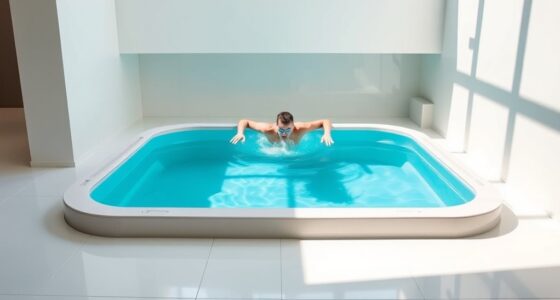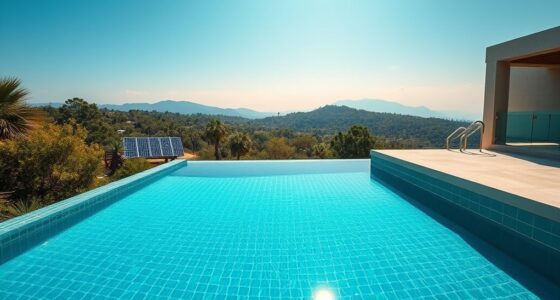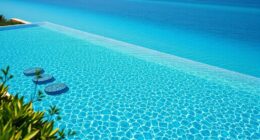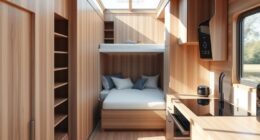To plan your indoor endless pool effectively, choose a spacious area close to changing rooms and bathrooms to make certain of easy access. Focus on proper ventilation with exhaust fans or dehumidifiers to control moisture and prevent mold. Use moisture-resistant materials for walls and floors for durability. Additionally, incorporate waterproof lighting and soundproofing to enhance safety and comfort. Paying attention to these details helps create a safe, functional, and relaxing space—keep going to explore expert tips on perfect site planning.
Key Takeaways
- Select a spacious, accessible area close to changing rooms and bathrooms for optimal convenience.
- Ensure proper ventilation with high-quality air exchange systems to manage moisture and air quality.
- Use moisture-resistant materials for walls, ceilings, and flooring to protect structural integrity.
- Design adequate clearance around the pool for maintenance, entry, and safe movement.
- Incorporate waterproof lighting and soundproofing to enhance safety, ambiance, and acoustics.

Planning the site for your indoor endless pool is a crucial step that guarantees safety, functionality, and long-term satisfaction. When selecting a pool room, you want to prioritize a space that’s both spacious and suitable for the specific needs of your pool. A well-designed pool room provides ample room for easy movement, maintenance, and accessories, preventing the area from feeling cramped or cluttered. Think about the layout carefully, ensuring there’s enough clearance around the pool for entering, exiting, and performing routine upkeep. The location within your home should also be convenient, ideally close to changing areas and bathrooms, to maximize comfort and usability.
One of the most critical aspects of indoor pool planning is ventilation design. Proper ventilation keeps humidity levels in check, preventing mold, mildew, and structural damage caused by excess moisture. When designing your ventilation system, consider installing a high-quality air exchange setup that can handle the moisture load generated by the pool. This might include exhaust fans, dehumidifiers, or an integrated HVAC system with dedicated humidity controls. Good ventilation also improves air quality, reducing chlorine fumes and other airborne contaminants, making the space healthier and more comfortable for you and your family. Ensuring proper air circulation is essential for maintaining a safe and comfortable environment.
Proper ventilation is essential to control humidity, prevent mold, and maintain a healthy indoor pool environment.
You should also think about the airflow patterns within your pool room to ensure even distribution and avoid stagnant air pockets. Proper ventilation design involves positioning vents and exhausts strategically, ideally with the help of a professional who understands the nuances of indoor pool environments. This way, you can maintain consistent humidity levels and prevent condensation on walls, ceilings, and windows. Additionally, consider using moisture-resistant materials for walls, ceilings, and flooring to further protect your investment and simplify maintenance.
Lighting and acoustics are other essential factors tied to your pool room’s design. Adequate lighting not only enhances visibility but also improves safety by highlighting potential hazards. Use waterproof, glare-free fixtures that can withstand humidity and splashes. Good acoustics can make your pool area more relaxing, so consider soundproofing if noise might disturb other parts of your home or neighbors.
Frequently Asked Questions
What Are the Best Ventilation Options for Indoor Pool Areas?
You should install a robust ventilation system to handle humidity and odors in your indoor pool area. Consider using an exhaust fan combined with a heat recovery ventilator for energy efficiency. Use a pool cover when the pool isn’t in use to reduce evaporation and humidity. Make certain your water filtration system is effective to keep the water clean, which also helps maintain better air quality in the space.
How Much Noise Isolation Is Needed for Indoor Endless Pools?
You should aim for significant noise isolation to guarantee a peaceful indoor pool environment. To improve pool acoustics, install soundproofing barriers around the pool area, especially near pumps and filtration systems. Consider adding acoustic panels or insulation to absorb sound and reduce noise transmission. This helps prevent disturbances both inside and outside the space, creating a more comfortable atmosphere for swimmers and nearby rooms.
What Are the Safety Considerations Specific to Indoor Pools?
You should prioritize safety by maintaining proper pool chemical safety to prevent harmful reactions and guarantee healthy water. Plan emergency exits clearly and accessibly to allow quick evacuation if needed. Keep safety equipment like life rings and first aid kits nearby. Regularly inspect the area for hazards, ensure proper ventilation, and educate users on safety protocols. These steps help create a secure environment for everyone using your indoor pool.
How Do I Ensure Proper Humidity Control Indoors?
To guarantee proper humidity control indoors, you should invest in a high-quality dehumidifier tailored for your space. This helps manage humidity levels effectively, preventing excess moisture that can lead to mold growth. Additionally, ensure good ventilation and use exhaust fans to improve airflow. Regularly monitor humidity levels with a hygrometer, aiming to keep them between 50-60%. Proper humidity management is key to mold prevention and maintaining a healthy indoor environment.
What Are the Optimal Lighting Setups for Indoor Pool Spaces?
Imagine a space where bright, natural light meets calming hues—your indoor pool benefits from thoughtful lighting design and soothing color schemes. You ought to opt for layered lighting, combining ambient, task, and accent lights to create a balanced glow. Use color schemes that complement water’s serenity, like cool blues and soft whites. This setup enhances ambiance, highlights architectural features, and guarantees safety, making your indoor pool both inviting and functional.
Conclusion
Think of your indoor endless pool as the heart of your wellness sanctuary. With careful site planning, you create a space that flows seamlessly, like a well-orchestrated symphony. When every detail aligns—from lighting to ventilation—you’ll enjoy a haven that rejuvenates your body and mind. Remember, a thoughtfully designed pool isn’t just a feature; it’s the beating core of your personal retreat, ready to refresh you whenever you need it most.









